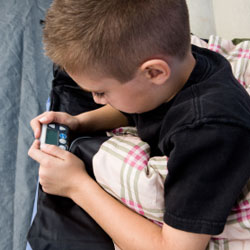|
Sick-Day Management --Children with Type 1 Diabetes
In children with diabetes, illness may upset the blood sugar balance. Sickness usually makes the blood sugar go up, even when the appetite is poor. However, sometimes the blood sugar stays the same or can even go low.
Frequent blood sugar and ketone checks will help you know what to do. Be prepared to give additional fast acting insulin as often as every 2 to 4 hours around the clock.
What to Do:
(adapted from "Guidelines for Managing "Sick" Days" by the Northern Diabetes Health Network, 2010)
1. Check the blood sugar and urine or blood ketones every 2 to 4 hours around the clock.
2. Never stop or skip the usual daily insulin doses. Illness can make the blood sugar go high even when your child is not eating.
3. When the blood sugar level is over 14 and you find ketones in the blood or urine, be ready to give extra rapid acting insulin immediately using the guide below.
4. If your child is unable to eat solid food, offer sugar-containing fluids instead. Give about 15 gm of carbohydrate per hour (see below for examples)
5. Take vomiting seriously. Vomiting with a high blood sugar level may be a sign of DKA. Vomiting can also lead to dehydration. Vomiting with a normal or low blood sugar can lead to hypoglycemia.
6. Take care of the illness that is upsetting the diabetes control. You may need to take your child to the doctor for diagnosis and treatment of the illness.
Insulin Dose Adjustment Guidelines
Check the blood sugar and ketone levels every 2 - 4 hours. Consult this chart and take the action recommended.
Blood Glucose
(mmol/L)
|
Blood Ketone Level
(mmol/L)
|
Urine Ketone Level |
Action Needed
Note: TDD means "Total Daily Dose"--see below how to calculate TDD
|
| <3.9 |
Any amount |
+ or - |
No extra insulin.
May decrease pre-meal insulin.
Consider mini-dose glucagon.
If vomiting, seek medical attention immediately.
|
| 4.0 - 14.0 |
less than 0.6 |
+ or - |
Take usual insulin dose (same as for non-sick day) |
| greater than 14.0 |
less than 0.6 |
- or small
|
Take 10% of TDD as rapid insulin now, in addition to the usual daily insulin doses |
| greater than 14.0 |
0.6 - 3.0 or greater |
Moderate to large |
Take 20% of TDD as rapid insulin now, in addition to the usual daily insulin doses.
Seek medical attention immediately.
|
How to calculate TDD (Total Daily Dose)
For children not on pumps
1. Add up the insulin doses that you would give on a regular day. This includes meal time insulin and basal insulin.
For example:
Usual dose at breakfast: 6 units
Usual dose at lunch: 4 units
Usual dose at supper: 8 units
Usual dose at bedtime: 10 units
TOTAL Daily Dose (TDD) = 28 units
10% of 28 units = 2.8 units (round to 3 units)
20% of 28 units = 5.6 units (round to 6 units)
|
If you feel unsure about the dose, check with your diabetes educator or physician. Do not delay! It is very important that your child gets enough insulin immediately.
For Children on Pumps
1. Add up how much insulin your child takes on a daily basis, including basal plus bolus insulin. This information can be found in the memory of the pump "daily totals".
For example: If the daily total = 32 units
10% of the TDD is 3.2 units (round to 3 units)
20% of the TDD is 6.4 units (round to 6 units)
Additional guidance for children on pumps experiencing illness
Vomiting with a high blood sugar and ketones must be treated as a pump failure until proven otherwise.
Discontinue the pump immediately and use a pen or syringe to inject rapid acting insulin in the amount of 10 - 20% of the TDD (see above). Do not use the pump until mechanical problems have been ruled out and a full set change has been done.
Remember: Children on pumps may get high blood sugar levels and DKA more quickly than children on injections because they use only rapid acting insulin. They have no background insulin in their system.
When your child on the pump is sick:
1. Check the blood sugar and the blood or urine for ketones every 2 to 4 hours.
2. Use the Insulin Dose Adjustment Guidelines (above) to determine what to do. During illness, the usual correction doses may not be enough.
3. When an illness makes the blood sugar go high, increase the basal rate temporarily by 20%. Further increases may need to be made depending on the results.
Important: When the blood sugar is high and you give the recommended correction (through the pump), you should see an effect. If the blood sugar does not go down by 3 mmol/L within 60 minutes, give the correction bolus by pen or syringe and change the infusion set.
Low Blood Sugar, Illness and Glucagon
Mini doses of Glucagon can be given to prevent severe hypoglycemia in times of acute illness.
When should you give mini-dose Glucagon during illness?
Use mini-dose Glucagon when your child's blood sugar level is under 4.0 AND he or she is unable or unwilling to take food or fluids to increase the blood sugar level due to the illness, nausea and/or vomiting.
Note: Give the full dose of Glucagon if your child is experiencing moderate or severe low blood sugar symptoms such as drowsiness, confusion, unconsciousness or convulsion.
To give Mini-dose Glucagon you will need:
- Glucagon
- An insulin syringe
- Blood glucose meter and strips
Mini-dose Glucagon Instructions:
1. Follow the instructions on the Glucagon package.
2. After mixing the Glucagon, use the insulin syringe (rather than the provided syringe) to draw up the glucagon.
3. Determine the dose needed:
- If the child is less than 2 years old: Dose = 2 units
- If the child is 2 years old or older: Dose = 1 unit per year of age (to a maximum of 15 units)
4. Pinch up the skin and inject the Glucagon.
5. If the blood glucose does not improve (is less than 5) in 30 minutes, give more Glucagon. This time, give double the first dose.
The DOUBLE DOSE is:
- If the child is less than 2 years old: Double dose = 4 units
- If the child is 2 years old or older: Double dose = 2 units per year of age (to a maximum of 15 units)
6. You may repeat the effective dose every hour, as needed, to keep the blood glucose greater than 5.
7. As blood glucose goes up, give about 15 grams of carbohydrates per hour by mouth.
|